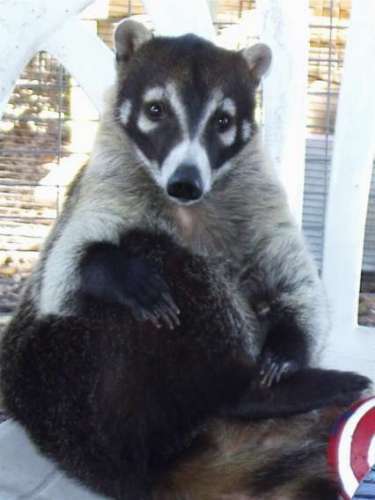 |
White Nosed Coati
Nasua Narica
Kingdom: | Animalia | Phylum: | Chordata | Class: | Mammalia | Order: | Omnivora | Family: | Procyonidae | Genus: | Nasua | Species: | Narica |
|
Description
A cousin to the raccoon, coatimundis are black to reddish brown. The under jaw, chin, throat, neck and chest are off-white. There are dark and light markings on the face with white markings around the nose. The feet are dark and the tail is ringed. The tail is usually carried upright when walking and is somewhat prehensile on the very tip, used for balancing in the trees. The nose is elongated and extremely flexible.
Click
Here to See White Nosed Coati Pictures
Average Statistics
Length | 3 to 4.5 ft | | Weight | 10 to 15 lbs | Geographic Range | Southeastern Arizona through Mexico and Central America and into western Colombia and Ecuador |
DietWhite-nosed coatis are omnivores that primarily eat insects. They will travel up to 2000 meters in a single day in a quest for food. They forage by keeping their muzzle down close to the forest floor and sniff around to find beetles, spiders, scorpions, ants, termites, grubs, centipedes, and even land crabs. When plentiful, fruit is also eaten. Occasionally coatis may search for small vertebrates, such as mice, lizards, and frogs. When hunting, coatis will "force vertebrates to the ground with their paws and kill by a bite to the head". Offspring2 and 7 young are born after a gestation period of 77 days. SoundsWhite nosed coaties and make a variety of squeaks and chirps. Relationship with HumansCoatis are hunted for their meat and may also be kept as pets. Their fur has no value. This species of coati was very plentiful in the 1950s, but suffered major population declines in the early 1960s for unknown reasons. Populations have since been recovering and this population increase has been accompanied by a northward extension of their range. The threats to their numbers are legal hunting by humans and several predators including cats, boas, and large predatory birds. |

